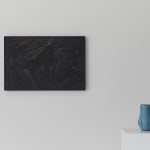Koizumi Junsaku (1924−2012)
Quietness
Color on paper, framed (25M)
Seal: Senshi
53 x 80 cm
55 x 82 cm (overall)
Seal: Senshi
53 x 80 cm
55 x 82 cm (overall)
Further images
Exhibitions
Koizumi Junsaku ten. Tokyo: Saikodo, 1972.Literature
Koizumi Junsaku gashu. Tokyo: Kyuryudo, 1990.
Koizumi Junsaku is best known for his ceiling paintings such as Unryu-zu (dragon and clouds) at Kencho-ji Temple in Kamakura, and Soryu-zu (two dragons) at Kennin-ji Temple in Kyoto. Yet such type of work, putting the purpose or the venue prior to the individual style, cannot be thought as typical of Koizumi’s work. Although each work, be it a two-year-spent ceiling painting, a tableau, a dessin, or even a pottery, without doubt reveals the spirit of the artist; the present work, produced for Koizumi's solo show in 1972 when he aged forty-eight, was the one that honestly manifested his own, true style at that time.
It arouses a feeling of surreal as if the viewers are standing on a gorge to look on to those overwhelming crags, the tracts of forest and the textures of mountain over yonder. Koizumi once wrote in his book Atorie kara no nagame (A view from my atelier), “When should I put a period to the painting in front of me? When can I be satisfied and put the brush down? I never feel it harder. …I think the difficulty is how to call for an end at the right time.” When we think of the “period” of this densely-painted work, the world Koizumi aspires after might occur to our mind.
Koizumi Junsaku (nihonga painter; 1924−2012)
Kanagawa-born nihonga painter. Graduated from the nihonga course of Tokyo School of Fine Arts. Studied under Yamamoto Kyujin. Active in exhibitions of Soga-kai and the Shinseisaku Art Society, later became independent and focused on one-man shows. Excelled at painting of flowers and ink wash landscape. Late in his life, produced ceiling painting and fusuma paintings for Kencho-ji Temple and other temples. Also studied pottery under Ogi Kyujiro. Received a special prize of Yamatane Museum of Art Nihonga Award.
It arouses a feeling of surreal as if the viewers are standing on a gorge to look on to those overwhelming crags, the tracts of forest and the textures of mountain over yonder. Koizumi once wrote in his book Atorie kara no nagame (A view from my atelier), “When should I put a period to the painting in front of me? When can I be satisfied and put the brush down? I never feel it harder. …I think the difficulty is how to call for an end at the right time.” When we think of the “period” of this densely-painted work, the world Koizumi aspires after might occur to our mind.
Koizumi Junsaku (nihonga painter; 1924−2012)
Kanagawa-born nihonga painter. Graduated from the nihonga course of Tokyo School of Fine Arts. Studied under Yamamoto Kyujin. Active in exhibitions of Soga-kai and the Shinseisaku Art Society, later became independent and focused on one-man shows. Excelled at painting of flowers and ink wash landscape. Late in his life, produced ceiling painting and fusuma paintings for Kencho-ji Temple and other temples. Also studied pottery under Ogi Kyujiro. Received a special prize of Yamatane Museum of Art Nihonga Award.





